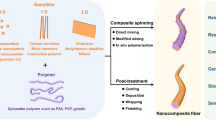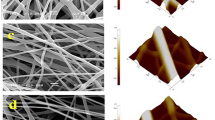Abstract
In this paper, PLA/RSF with different mass ratios and aspirin-loaded PLA/RSF composite nanofiber membranes were prepared via electrospinning. Polylactic acid (PLA) and regenerated silk fibroin (RSF) were dissolved in trifluoroacetic acid and dichloromethane at a volume ratio of 70/30. The structure analysis made by Fourier transform infrared spectroscopy (FTIR) suggested that PLA and RSF blended very well in the composite membranes. In addition, scanning electron microscopy (SEM) and transmission electron microscopy (TEM) revealed that the average diameters of composite nanofibers were between 80 and 210 nm. Furthermore, the composite nanofibers had better uniformity in the range of the experiment, and the average diameter of composite nanofibers decreased with the increase of aspirin content. Wettability performance was investigated via contact water angle meter; the hydrophilic property of composite membranes had been improved with the existence of SF. Drug release property was tested by detecting the absorbency of drug in PBS solution via UV–visible spectroscopy, and the results showed that drug release rate reached the maximum when the mass ratio of PLA/RSF was 8/3. With the raise of aspirin content, the drug release rate increased. The in vitro anticoagulation behavior was studied by static platelet adhesion test. The results revealed that the anticoagulation property of composite membranes was superior to that of pure PLA nanofiber membranes. The anticoagulation property significantly improved in the presence of aspirin.








Similar content being viewed by others
References
Fei YN, Chen Y, Wang HB, Gao WD, Yang RH, Wan YQ (2011) Preparation, characterization of antibacterial PLA/TP nanofibers. Fiber Polym 12:340–344
Kim EN, Kim SH, Lee CH (2010) Electrospinning of polylactide fibers containing silver nanoparticles. Macromol Res 18:215–221
Nagarwal RC, Kumar R, Dhanawat M, Pandit JK (2011) Modified PLA nano in situ gel: A potential ophthalmic drug delivery system. Colloids Surf B 86:28–34
Dev A, Binulal NS, Anitha A, Nair SV, Furuike T, Tamura H, Jayakumar R (2010) Preparation of poly(lactic acid)/chitosan nanoparticles for anti-HIV drug delivery applications. Carbohydr Polym 80:833–838
Rujiravanit R, Kruaykitanon S, Jamieson AM, Tokura S (2003) Preparation of crosslinked chitosan/silk fibroin blend films for drug delivery system. Macromol Biosci 3:604–611
Tsukada M, Goto Y, Freddi G, Shiozaki H (1992) Chemical modification of silk with aromatic acid anhydrides. J Appl Polym Sci 45:1189–1194
Wang XQ, Yucel T, Lu Q, Hu X, Kaplan DL (2010) Silk nanospheres and microspheres from silk/pva blend films for drug delivery. Biomaterials 31:1025–1035
Wenk E, Wandrey AJ, Merkle HP, Meinel L (2008) Silk fibroin spheres as a platform for controlled drug delivery. J Control Release 132:26–34
Meinel L, Betz O, Fajardo R, Hofmann S, Nazarian A, Cory E, Hilbe M, McCool J, Langer R, Vunjak-Novakovic G, Merkle HP, Rechenberg B, Kaplan DL, Kirer-Head C (2006) Silk based biomaterials to heal critical sized femur defects. Bone 39:922–931
Hofmann S, Knecht S, Langer R, Kaplan DL, Vunjak-Novakovic G, Merkle HP, Meinel L (2006) Cartilage-like tissue engineering using silk scaffolds and mesenchymal stem cells. Tissue Eng 12:2729–2738
Li LH, Li HB, Qian YN, Li X, Singh GK, Zhong L, Liu WQ, Lv YG, Cai KY, Yang L (2011) Electrospun poly (ε-caprolactone)/silk fibroin core-sheath nanofibers and their potential applications in tissue engineering and drug release. Int J Biol Macromol 49:223–232
Galloway CF, Stevenson JC (2011) Aspirin in the primary prevention of cardiovascular disease. Maturitas 68:3–4
Wang SD, Zhang YZ, Yin GB, Wang HW, Dong ZH (2009) Electrospun polylactide/silk fibroin–gelatin composite tubular scaffolds for small-diameter tissue engineering blood vessels. J Appl Polym Sci 113:2675–2682
Zhang KH, Yin AL, Huang C, Wang CY, Mo XM, Al-Deyab SS, El-Newehy M (2011) Degradation of electrospun SF/P(LLA-CL) blended nanofibrous scaffolds in vitro. Polym Degrad Stab 96:2266–2275
Zhou WT, He JX, Du S, Cui SZ, Gao WD (2011) Electrospun silk fibroin/cellulose acetate blend nanofibres: structure and properties. Iran Polym J 20:389–397
Chen Y, Lin J, Fei YN, Wang HB, Gao WD (2010) Preparation and characterization of electrospinning PLA/curcumin composite membranes. Fiber Polym 11:1128–1131
He CL, Wang M, Cai XM, Huang XB, Li L, Zhu HM, Shen J, Yuan J (2011) Chemically induced graft copolymerization of 2-hydroxyethyl methacrylate onto polyurethane surface for improving blood compatibility. Appl Surf Sci 258:755–760
Cheung H-Y, Lau K-T, Tao X-M, Hui D (2008) A potential material for tissue engineering: silkworm silk/PLA biocomposite. Compos Part B Eng 39:1026–1033
Zhao YY, Yang QB, Lu XF, Wang C, Wei Y (2005) Study on correlation of morphology of electrospun products of polyacrylamide with ultrahigh molecular weight. J Polym Sci, Part B: Polym Phys 43:2190–2195
Chen X, Knight DP, Shao ZZ, Vollrath F (2001) Regenerated bombyx silk solutions studied with rheometry and FTIR. Polym 42:09969–09974
Risbud MV, Bhat SV, Bhonde RR, Hardika AA (2000) pH-sensitive freeze-dried chitosan–polyvinyl pyrrolidone hydrogels as controlled release system for antibiotic delivery. J Control Release 68:23–30
Peng T, Yao KD, Yuan C, Goosen MFA (1994) Structural changes of pH-sensitive chitosan/polyether hydrogels in different pH solution. J Polym Sci A Polym Chem 32:591–596
Yao KD, Peng T, Feng HB, He YY (1994) Swelling kinetics and release characteristic of crosslinked chitosan: polyether polymer network (semi-IPN) hydrogels. J Polym Sci A Polym Chem 32:1213–1223
Almeria B, Deng WW, Fahmy TM, Gomez A (2010) Controlling the morphology of electrospray-generated PLGA microparticles for drug delivery. J Colloid Interface Sci 343:125–133
Muthumanickkam A, Subramanian S, Goweri M, Beaula WS, Ganesh V (2013) Comparative study on eri silk and mulberry silk fibroin scaffolds for biomedical applications. Iran Polym J 22:143–154
Song XF, Gao ZT, Ling FG, Chen XS (2012) Controlled release of drug via tuning electrospun polymer carrier. J Polym Sci B Polym Phys 50:221–227
Huang X-J, Guduru D, Xu Z-K, Vienken J, Groth T (2011) Blood compatibility and permeability of heparin-modified polysulfone as potential membrane for simultaneous hemodialysis and LDL removal. Macromol Biosci 11:131–140
Kumar KP, Paul W, Sharma CP (2011) Green synthesis of gold nanoparticles with Zingiber officinale extract: characterization and blood compatibility. Process Biochem 46:2007–2013
Acknowledgments
The authors wish to acknowledge the financial support from (1) Jiangnan University scientific researches fund for doctoral students, (2) the Jiangsu Provincial Natural Science Foundation of China (No. BK2012112) and (3) the National Natural Science Foundation of China under Grant No. 31201134.
Author information
Authors and Affiliations
Corresponding author
Rights and permissions
About this article
Cite this article
Qin, J., Jiang, Y., Fu, J. et al. Evaluation of drug release property and blood compatibility of aspirin-loaded electrospun PLA/RSF composite nanofibers. Iran Polym J 22, 729–737 (2013). https://doi.org/10.1007/s13726-013-0171-1
Received:
Accepted:
Published:
Issue Date:
DOI: https://doi.org/10.1007/s13726-013-0171-1




